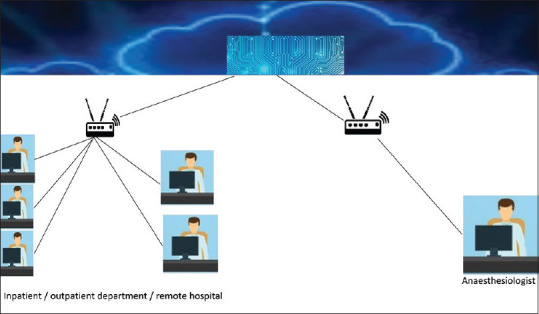Sir,
Pre-anaesthetic check-up (PAC) is now an integral part of perioperative anaesthetic care. Current literature suggests that all patients undergoing anaesthesia must have a PAC by an anaesthesiologist.[1] It has been proven to be effective in providing cost-effective and quality care to surgical patients undergoing elective surgeries. However, the recent worldwide corona pandemic has disrupted the standard operating procedure of most of the hospitals. Although non-urgent surgeries are being advised to be postponed or minimised,[2] it is not feasible for a longer duration. From the current scenario and development, it is well expected that the corona pandemic is likely to affect humanity for a relatively longer duration. In such a situation, it will be imperative to restart the elective surgeries soon. Further, a good number of the patients with cancer require surgical management, which cannot be postponed for a long duration. Considering these facts, a cloud computing-based remote PAC of the patients scheduled for surgeries is proposed.
Software will be used as a tool and cloud computing technology will act as the connecting link between the patients and the anaesthesiologists. A good number of software for anaesthesia information management and even hospital information management systems are available commercially or can even be customised and developed locally. The software is prepared to note the patients' history, physical condition, laboratory findings and other relevant findings. Airway assessment section will also give an idea about the possible difficulties by answering a few questions and noting them in the software. The data will be filled up by the inpatient/outpatient/remote hospital and will be saved in the cloud. The designated anaesthesiologist will evaluate the data entered and accordingly prescribe pre-operative advice. The advice will also be saved in the cloud and the respective department can access it and work/follow it accordingly [Figure 1]. The user will have access using usernames and passwords only for authentic use.
Figure 1.

Representation of cloud computing-based remote preanaesthetic check-up
Cloud computing is the on-demand availability of computer system resources such as data storage, servers, databases and networking services and software from a web browser via the internet. Information technology-based joint PAC has been conceptualised and proposed.[3] This adapted method will have an impact in a few ways during this corona pandemic. The patient will not require to attend another outpatient department (OPD), i.e., PAC clinic, or there will be reduced requirement of anaesthesia resident visits to the inpatient department (IPD). This, in turn, will help in reducing personal contacts and even cross-infection and coronavirus spread. The patient is invariably examined by the residents and/or interns in the surgical OPD or IPD on the first contact or after admission, and the findings can be entered in the software at the same time. A formal PAC can reduce the last-minute cancellation of the case,[4] and this adapted PAC is also likely to benefit the patients by doing so as compared to no PAC. Further, this can also help in integrating perioperative medicine and anaesthesia in an efficient way, which is the need of the hour.[5]
The proposed method is likely to benefit the patients, but is expected to have some limitations. The education level and intelligence of the patient as well as the PAC-related knowledge of the intern or non-anaesthesia residents will play a limiting role in understanding questions and providing its answers by the patients. However, this issue can be mitigated to a great extent using a simple questionnaire-based data entry wherever applicable. Further, the availability of internet and smartphone, especially in remote locations, is another limitation. Although the basic information such as blood pressure, pulse rate and weight of the patient can be easily obtained even in primary care-level hospitals, it may not be possible if patients do not attend a nearby health-care centre. The airway examination is expected to be limited,[6] but the management is unlikely to be affected. This is because all patients are invariably examined by the anaesthesiologist responsible for conducting anaesthesia before taking for anaesthesia, and accordingly decisions can be made. Similarly, direct respiratory and cardiovascular examinations are not possible if not examined by an intern or resident. A questionnaire-based answer for evaluating the metabolic equivalent of tasks (METs) can only give fair information of cardiopulmonary reserve. Hence, the method will not be much effective for high-grade American Society of Anaesthesiologists physical status patients. Nevertheless, low METs will indicate that the patient will require a physical appointment or referral for further evaluation. Finally, even though we propose a cloud-based method, this can be even done over the local area network (LAN). However, the remote access facility will not be there in the LAN-based technique.
Financial support and sponsorship
The author has received financial assistance from All India Institute of Medical Sciences, Raipur for the development of similar software for an intramural project.
Conflicts of interest
There are no conflicts of interest.
REFERENCES
- 1.Sweitzer BJ. Crowley M, editor. Preanesthesia evaluation for noncardiac surgery. Up-to-Date Waltham (MA): UpToDate; 20120. [[Last accessed on 2020 May 20]]. Available from: https://wwwuptodatecom/contents/preanesthesia-evaluation-for-noncardiac-surgery .
- 2.Stahel PF. How to risk-stratify elective surgery during the COVID-19 pandemic? Patient Saf Surg. 2020;14:8. doi: 10.1186/s13037-020-00235-9. [DOI] [PMC free article] [PubMed] [Google Scholar]
- 3.Karim HM. Adopting information management based joint preoperative assessment and risk stratification model to save surgical care cost. J Anesth Surg. 2017;4:7–8. [Google Scholar]
- 4.Gupta A, Gupta N. Setting up and functioning of a preanaesthetic clinic. Indian J Anaesth. 2010;54:504–7. doi: 10.4103/0019-5049.72638. [DOI] [PMC free article] [PubMed] [Google Scholar]
- 5.Shah SB, Hariharan U, Chawla R. Integrating perioperative medicine with anaesthesia in India: Can the best be achieved.A review? Indian J Anaesth. 2019;63:338–49. doi: 10.4103/0019-5049.258058. [DOI] [PMC free article] [PubMed] [Google Scholar]
- 6.Singh SA, Pandey VK, Prakash K, Choudhary V. A failure of pre-anaesthetic check-up leading to unsuspected difficult intubation. Indian J Anaesth. 2016;60:863–4. doi: 10.4103/0019-5049.193697. [DOI] [PMC free article] [PubMed] [Google Scholar]


